
|
The Route. The route took us from
east to west across the southern part of Death Valley National
Park. Death Valley is isolated by the Amargosa mountain range in
the east, and the Panamint range in the west. Our plan was to
enter the park on pavement, then cross west over the Panamint range by
four-wheel drive trail. |
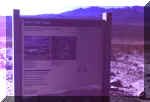
|
West Side Road. After entering the
south side of the park, we folowed highway 178 past the Ashford Mill
ruins, then branched off onto the West Side Road. This road runs
up the west side of the valley, with elevations frequently quite a bit
below sea level (in fact, Melanie, in the middle of a cold, had awful
pain in one of her ears from the air pressure!). The road
was wide, graded, and in good shape, and we followed it approximately
5 miles. |

|
Over the Panamints. Leaving the West
Side Road, the road over the
Panamint Range begins with Butte Valley road. This road travels
up Warm Springs Canyon, then on into Butte Canyon. After the
road climbs over Mengel Pass, it turns into Coyote Canyon Road and
descends Goler Wash.
Pictured at left is a portion of the National Park Service map with
the route highlighted in yellow. |

|
Starting up Butte Valley Road.
Butte Valley road started as a nice, graded, sand and gravel
road. Scenery was beautiful, and we drove west across the
valley, slowly climbing towards the mountains in the west. Early
on we encountered a couple coming from the west, who had difficulty
with their long-wheelbase Toyota over the pass; they also somehow
managed to tear both front mudflaps from their truck. |

|
Climbing Butte Valley Road. The road
continued to climb as we traveled through higher and higher
elevations. Road conditions continued to be good: a nice
sandy track through the desert. Along the way we encountered
some motorcycle riders who needed air to fix a flat -- we had the air
compressor, but couldn't help them because their patch kit was with
another rider who was unable to make it up Goler wash and had to turn
back. |

|
Satellite View of our Track Across the Desert. To be sure we were
on the right course, we used GPS satellite navigation along the
route. The mapping information displayed on the GPS, along with
the topographical map, allowed us to be sure we were on the right
trail throughout the trip. Since there were numerous forks, we
really didn't want to wind up going the wrong direction! The
view at left shows the track log recorded by the GPS. |

|
Abandoned Mine, Warm Springs Canyon.
Once we climbed into Warm Springs Canyon, we saw lots of old mining
activity. Open mineshafts dotted the hills on either side of the
canyon, and tailing piles were scattered on the slopes.
Occasionally we'd see abandoned machinery, such as pictured
here. |
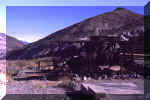
|
Abandoned Mine. Another abandoned
mine in Warm Springs Canyon had lots of foundations, mineshafts, and
rusting equipment. Also in the background were numerous
abandoned miner's cabins. This point marked the end of the
"good" road and the beginning of the high clearance 4WD part
of the route: From here on over the mountains, the road was more
of a trail made up of loose sand, gravel, rocks, and boulders. |
|
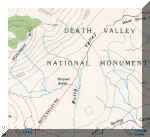
|
Butte Valley. This high desert
valley is 4000' above Death Valley just 15 miles (line-of-sight) to
the east. The topo map showed a relatively good route towards
Mengel Pass in the west.. |

|
Climbing towards Butte Valley.
After several hours we made the last part of the climb before we
reached Butte Valley. Near this point we encountered two
vehicles coming from the other direction, who reported Mengel Pass to
be difficult but passable. |

|
Other 4WD Drivers in the Distance. Once
in the valley, we had a clear view of the road across to the
pass. On the opposite (west) side of the valley, there are more
abandoned cabins in the hills; these are often used overnight by
travelers through this area. Once the road crosses the valley
(as pictured), it turns left (south) to go over the pass. Off in
the distance we could see two other vehicles going our same
direction. |
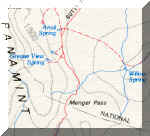
|
Mengel Pass. The road towards
Mengel Pass on the west side of Butte Valley was quite exciting.
After passing by the cabins near Greater View Spring, the sandy +
rocky trail turned quite difficult. From here to the pass, the
trail consisted of hard-packed and loose sand, studded with rocks of
numerous sizes. The trail was never level, either ascending or
descending (sometimes very steeply!), and frequently off-camber with
nerve-wracking pitches to the left and right. Numerous times we
had to get out and walk the trail ahead to decide the best
route. Three times we scraped our way over large rocks. |

|
Reaching Mengel Pass. After a few
miles of really rough climbing, we reached the pass.
Fortunately, the two vehicles that we had spotted ahead of us had
stopped at the cabins and were now behind us, so we didn't feel
completely alone in the trip towards the pass. One of the two
can be seen climbing towards the pass at left. |
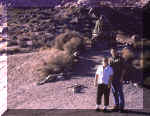
|
Stone Marker, Mengel Pass. The
summit is marked with a stone cairn -- of course we had to set the
self-timer on the camera and run to get a picture! |

|
Goler Wash. The next part of the
route was marked on the topo map with a dotted line (suggesting it was
even worse than what we had just gone through!). The road
descends from the pass down Coyote Canyon through Goler Wash.
All the information I could find about this route said that Goler Wash
was the most difficult part of the trip, but I hoped that since we
were going east-to-west, and descending, we could use gravity
to help us over the difficult stuff. |
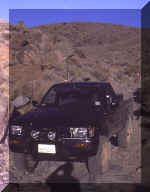
|
Descending from the Pass to the Wash.
The trail to the wash was rough but entirely passable. Lots of
big boulders and rocks, but not too many off-camber sections, and not
too much loose sand. As long as we drove slowly (we hadn't been
out of 4-low second gear since the mines!) things were stable. |

|
Trail from Mengel Pass to Goler Wash.
At left is a driver's view shot of the trail descending down towards
the wash. Interesting angles in this shot, plus, the road seems
to disappear! |

|
Pausing in the Canyon. The sun was
close to setting, and we wanted to be out of Goler Wash by night, and
it looked like we were going to make it. The wash had more loose
rocks and boulders, but going downhill was relatively easy. |

|
Goler Wash. More of the wash.
Steep canyon walls extended several hundred feet on either side of the
trail. |
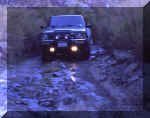
|
Water in Goler Wash. After not
seeing any signs of water for several hours, it was quite exciting to
see water running down the wash as we descended. |

|
Hanging Boulders, Goler Wash. At
several places along the canyon walls, giant boulders are wedged into
gaps in the rock. Piled on these boulders are heaps of smaller
boulders and other rocks. Not the place I'd want to be in a
flash flood!
Note the barrel cacti dot the rock walls in this area.
I was able to meet up with the regular ham radio group on 14.339
MHz around this time -- with cell phone service out of range for
hours, and no VHF or UHF repeaters nearby, it's always nice to use the
HF radio to chat with people from such an isolated area!! |

|
Panamint Valley. Just after the sun
set we reached Panamint Valley (elevation approx. 1000') and the end
of the 4WD road. We continued north up the valley on the rough
washboarded sand road for approx. 15 miles towards the ghost town of
Ballarat. Next we turned west for several miles, got on to our
first paved road in five hours, and continued north towards home (only
9 hours away!). |

|
Postscript: Dings and Scratches.
Other than some minor scrapes on the underside of the truck (sure am
glad they protect the differential drain plug with an armor ring!),
the only other sign we'd been trail-riding was the dust on the wheels
and numerous fine scratches along the sides of the truck.
They'll come out... |



